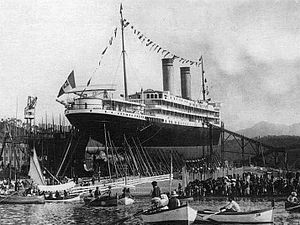
Ceremonial ship launching involves the performance of ceremonies associated with the process of transferring a vessel to the water. It is a nautical tradition in many cultures, dating back thousands of years, to accompany the physical process with ceremonies which have been observed as public celebration and a solemn blessing, usually but not always, in association with the launch itself.

HMHS RMS Britannic was the third and final Olympic class ocean liner of steamships and the second White Star ship to bear the name Britannic. She was the youngest sister of the RMS Olympic and the RMS Titanic and was intended to enter service as a transatlantic passenger liner. She was operated as a hospital ship from 1915 until her sinking near the Greek island of Kea, in the Aegean Sea, in November 1916. At the time she was the largest hospital ship in the world.

An ocean liner is a type of passenger ship primarily used for transportation across seas or oceans. Ocean liners may also carry cargo or mail, and may sometimes be used for other purposes. Only one ocean liner remains in service today.

Europa, later Liberté IMO 5607332, was a German ocean liner built for the Norddeutsche Lloyd line (NDL) to work the transatlantic sea route. She and her sister ship, Bremen, were the two most advanced, high-speed steam turbine ocean vessels in their day, with both earning the Blue Riband.

Imperator was a German ocean liner built for the Hamburg America Line, launched in 1912. At the time of her completion in June 1913, she was the largest passenger ship in the world by gross tonnage, surpassing the new White Star liner Olympic.

Swedish American Line was a Swedish passenger shipping line. It was founded in December 1914 under the name Rederiaktiebolaget Sverige-Nordamerika and began ocean liner service from Gothenburg to New York in 1915. In 1925 the company changed its name to Svenska Amerika Linien / Swedish American Line.

The fifth SS Rotterdam, also known as "The Grande Dame", is a former ocean liner and cruise ship, and has been a hotel ship in Rotterdam, Netherlands, since 2010. She was launched by Queen Juliana of the Netherlands in a gala ceremony on 13 September 1958, and was completed the following summer.

The Olympic-class ocean liners were a trio of British ocean liners built by the Harland & Wolff shipyard for the White Star Line during the early 20th century. They were Olympic (1911), Titanic (1912) and Britannic (1914). All three were designed to be the largest and most luxurious passenger ships at that time, designed to give White Star an advantage in the transatlantic passenger trade.

RMS Sylvania was an ocean liner built in 1957 by John Brown & Co (Clydebank), in Glasgow, for the United Kingdom-based shipping company Cunard Line. She was the last Cunard Line vessel built specifically for transatlantic crossings. The ship was later heavily rebuilt as a cruise ship, and sailed under the names SS Fairwind, SS Sitmar Fairwind, SS Dawn Princess and SS Albatros before being scrapped in 2004. She was renamed SS Genoa for her last voyage.

SS Arctic was a 2,856-ton paddle steamer, one of the Collins Line, which operated a transatlantic passenger and mail steamship service during the 1850s. She was the largest of a fleet of four, built with the aid of U.S. government subsidies to challenge the transatlantic supremacy of the British-backed Cunard Line. During her four-year period of service, the ship was renowned both for her speed and for the luxury of her accommodation.

SS Leonardo da Vinci was an ocean liner built in 1960 by Ansaldo Shipyards, Italy for the Italian Line as a replacement for their SS Andrea Doria that had been lost in 1956. She was initially used in transatlantic service alongside SS Cristoforo Colombo, and primarily for cruising after the delivery of the new SS Michelangelo and SS Raffaello in 1965. In 1976 the Leonardo da Vinci became the last Italian Line passenger liner to be used in service across the North Atlantic. Between 1977 and 1978 she was used as a cruise ship by Italia Crociere but was laid up from 1978 onwards until 1982 when she was scrapped.
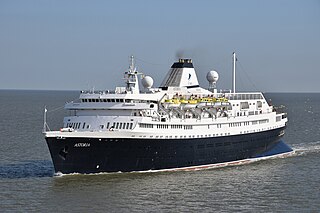
MV Astoria is a ship that was constructed as the transatlantic ocean liner Stockholm for Swedish American Line, and rebuilt as a cruise ship in 1993. Ordered in 1944, and commenced service in 1948, at 76 years old, she is the oldest deep water passenger liner still around in a non retired status. As Stockholm, she was best known for an accidental collision with Andrea Doria in July 1956, resulting in the sinking of the latter ship and 46 fatalities off the coast of Nantucket, Massachusetts, United States.

MS Stockholm was the name of two near-identical ocean liners built by Cantieri Riuniti dell' Adriatico, Monfalcone, Italy between 1936 and 1941 for the Swedish American Line. Neither of the ships entered service for the company that had ordered them—the first ship was entirely destroyed by fire during construction in 1938, while the second was completed in 1941 but immediately sold to the Italian government as a troopship. The second ship served for three years in the Regia Marina and Kriegsmarine under the name MS Saubadia, until sunk by British bombers outside Trieste in 1944. It is unknown if she was ever actually used as a troopship.
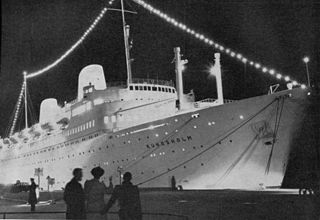
MS Kungsholm was a combined ocean liner / cruise ship built in 1953 by the De Schelde shipyard in Vlissingen, the Netherlands for the Swedish American Line. Between 1965 and 1981 she sailed for the North German Lloyd and their successor Hapag-Lloyd as MS Europa. From 1981 until 1984 she sailed for Costa Cruises as MS Columbus C. She sank in the port of Cadiz, Spain after ramming a breakwater on 29 July 1984. The vessel was refloated later that year, but sent to a Barcelona shipbreaker in 1985 for scrapping.
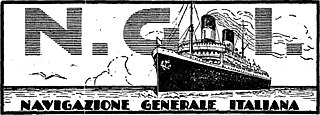
Navigazione Generale Italiana (NGI) was an Italian shipping company.
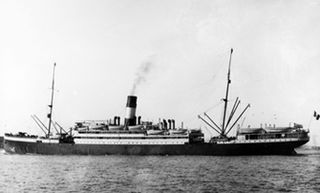
SS Taormina was a transatlantic ocean liner that was launched in Scotland in 1907 for an Italian shipping line. She was owned successively by Italia Società di Navigazione a Vapore, Lloyd Italiano and Navigazione Generale Italiana (NGI). Taormina was briefly chartered as a troop ship for the US Armed Forces in 1918. She was scrapped in 1929.

The "Big Four" were a quartet of early-20th-century 20,000-ton ocean liners built by the Harland & Wolff shipyard for the White Star Line, to be the largest and most luxurious ships afloat. The group consisted of Celtic, Cedric, Baltic and Adriatic.

SSPrincipessa Mafalda was an Italian transatlantic ocean liner built for the Navigazione Generale Italiana (NGI) company. Named after Princess Mafalda of Savoy, second daughter of King Victor Emmanuel III, the ship was completed and entered NGI's South American service between Genoa and Buenos Aires in 1909. Her sister ship SS Principessa Jolanda sank immediately upon launching on 22 September 1907.

SS Patria was an 11,885 GRT French ocean liner built in 1913 for Compagnie française de Navigation à vapeur Cyprien Fabre & Cie, for whom she was first a transatlantic liner and then an emigrant ship. From 1932 Fabre Line leased her to Services Contractuels des Messageries Maritimes, who ran her between the south of France and the Levant. After the fall of France in June 1940 the British authorities in Mandatory Palestine seized her in the Port of Haifa and placed her under the management of the British-India Steam Navigation Company. In November 1940, the Zionist movement Haganah planted a bomb aboard which sank her with the loss of between 260 and 300 lives. Patria remained a wreck in Haifa port until she was scrapped in 1952.
SS Verona was a transatlantic ocean liner that was built in Ireland in 1908 for an Italian shipping line. She was a troop ship in the Italo-Turkish War of 1911–12 and in the First World War in 1917–18. In 1918 a German submarine sank her in the Mediterranean with great loss of life.
